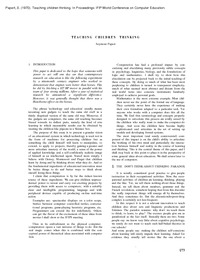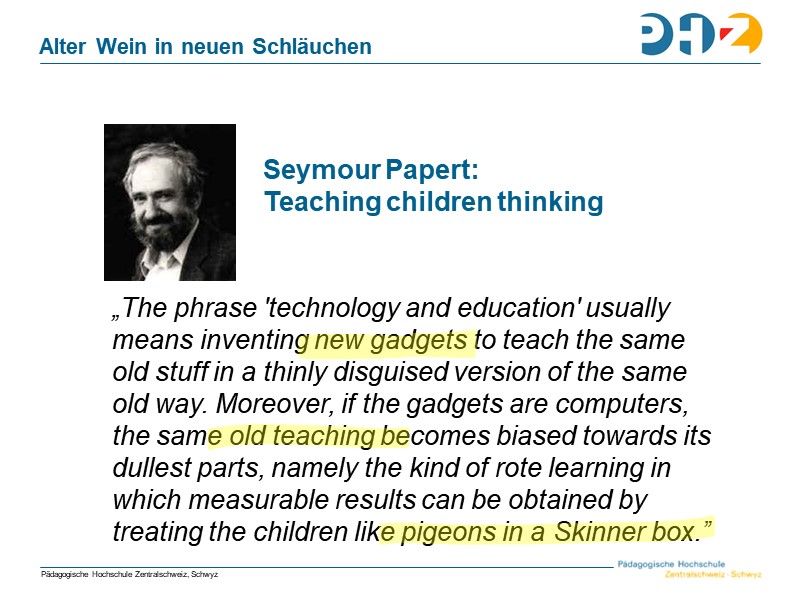Teaching children thinkingLogo Memo No. 2
Erstpublikation in: Proc. IFIP World Conf. on Computer Education
Publikationsdatum:
Zu finden in:
|
 |
 Diese Seite wurde seit 1 Jahr inhaltlich nicht mehr aktualisiert.
Unter Umständen ist sie nicht mehr aktuell.
Diese Seite wurde seit 1 Jahr inhaltlich nicht mehr aktualisiert.
Unter Umständen ist sie nicht mehr aktuell.
 Zusammenfassungen
Zusammenfassungen
 This paper is dedicated to the hope that someone with power to act will one day see that contemporary research on education is like the following experiment by a nineteenth century engineer who worked to demonstrate that engines were better than horses. This he did by hitching a 1/8 HP motor in parallel with his team of four strong stallions. After a year of statistical research he announced a significant difference. However, it was generally thought that there was a Hawthorne effect on the horses.
This paper is dedicated to the hope that someone with power to act will one day see that contemporary research on education is like the following experiment by a nineteenth century engineer who worked to demonstrate that engines were better than horses. This he did by hitching a 1/8 HP motor in parallel with his team of four strong stallions. After a year of statistical research he announced a significant difference. However, it was generally thought that there was a Hawthorne effect on the horses. The phrase 'technology and education' usually means inventing new gadgets to teach the same old stuff in a thinly disguised version of the same old way. Moreover, if the gadgets are computers, the same old teaching becomes biased towards its dullest parts, namely the kind of rote learning in which measurable results can be obtained by treating the children like pigeons in a Skinner box.
The phrase 'technology and education' usually means inventing new gadgets to teach the same old stuff in a thinly disguised version of the same old way. Moreover, if the gadgets are computers, the same old teaching becomes biased towards its dullest parts, namely the kind of rote learning in which measurable results can be obtained by treating the children like pigeons in a Skinner box.The purpose of this essay is to present a grander vision of an educational system in which technology is used not in the form of machines for processing children but as something the child himself will learn to manipulate, to extend, to apply to projects, thereby gaining a greater and more articulate mastery of the world, a sense of the power of applied knowledge and a self-confidently realistic image of himself as an intellectual agent. Stated more simply, I believe with Dewey, Montessori and Piaget that children learn by doing and by thinking about what they do. And so the fundamental ingredients of educational innovation must be better things to do and better ways to think about oneself doing these things.
 Bemerkungen
Bemerkungen
 This paper is dedicated to the hope that someone with
power to act will one day see that contemporary
research on education is like the following experiment
by a nineteenth centuiy engineer who worked to
demonstrate that engines were better than horses. This
he did by hitching a 1/8 HP motor in parallel with his
team of four strong stallions. After a year of statistical
research he announced a signifcant difference.
However, it was generally thought that there was a
Hawthorne effect on the horses
This paper is dedicated to the hope that someone with
power to act will one day see that contemporary
research on education is like the following experiment
by a nineteenth centuiy engineer who worked to
demonstrate that engines were better than horses. This
he did by hitching a 1/8 HP motor in parallel with his
team of four strong stallions. After a year of statistical
research he announced a signifcant difference.
However, it was generally thought that there was a
Hawthorne effect on the horses The purpose of this essay is to present a grander vision of an educational system in which technology is used not in the form of machines for processmg children but as something the child himself will learn to manipulate, to extend, to apply to projects, thereby gaining a greater and more articulate mastery of the world, a sense oi'the power of applied knowledge and a self-confidently realistic image of himself as an intellectual agent. Stated more simply, I believe with Dewey, Montessori and Piaget that children learn by doing and by thinking about what they do. And so the fundamental ingredients of educational innovation must be better things to do and better ways to think about oneself doing these things.
The purpose of this essay is to present a grander vision of an educational system in which technology is used not in the form of machines for processmg children but as something the child himself will learn to manipulate, to extend, to apply to projects, thereby gaining a greater and more articulate mastery of the world, a sense oi'the power of applied knowledge and a self-confidently realistic image of himself as an intellectual agent. Stated more simply, I believe with Dewey, Montessori and Piaget that children learn by doing and by thinking about what they do. And so the fundamental ingredients of educational innovation must be better things to do and better ways to think about oneself doing these things. Dieser Text erwähnt ...
Dieser Text erwähnt ...
 Personen KB IB clear | John Dewey , Maria Montessori , Jean Piaget |
 Begriffe KB IB clear | CAIcomputer aided instruction
,  Computer Computer computer
, computer
,  Denken Denken thinking
, Informatikcomputer science
, thinking
, Informatikcomputer science
,  Kinder Kinder children
, children
,  Lernen Lernen learning
, LISP
, learning
, LISP
,  LOGO (Programmiersprache) LOGO (Programmiersprache) LOGO (programming language)
, LOGO (programming language)
,  MIT MIT
|
 Dieser Text erwähnt vermutlich nicht ...
Dieser Text erwähnt vermutlich nicht ... 
 Nicht erwähnte Begriffe | Eltern, Informatik-Didaktik, Informatik-Unterricht (Fachinformatik), LehrerIn, Schule, Unterricht |
 Tagcloud
Tagcloud
 Zitate aus diesem Text
Zitate aus diesem Text
 It is said that the best way to learn something is to teach it. Perhaps writing a teaching program is better still in its insistance on forcing one to consider all possible misunderstandings and mistakes.
It is said that the best way to learn something is to teach it. Perhaps writing a teaching program is better still in its insistance on forcing one to consider all possible misunderstandings and mistakes. The phrase 'technology and education' usually means
inventing new gadgets to teach the same old stuff in a
thinly disguised version of the same old way. Moreover, if
the gadgets are computers, the same old teaching becomes biased towards its dullest parts, namely the kind of rote learning in which measurable results can be obtained by treating the children like pigeons in a Skinner box.
The phrase 'technology and education' usually means
inventing new gadgets to teach the same old stuff in a
thinly disguised version of the same old way. Moreover, if
the gadgets are computers, the same old teaching becomes biased towards its dullest parts, namely the kind of rote learning in which measurable results can be obtained by treating the children like pigeons in a Skinner box. Vorträge von Beat mit Bezug
Vorträge von Beat mit Bezug
 Zitationsgraph
Zitationsgraph
 Zitationsgraph (Beta-Test mit vis.js)
Zitationsgraph (Beta-Test mit vis.js)
 Zeitleiste
Zeitleiste
 12 Erwähnungen
12 Erwähnungen 
- Rechner-Gestützter Unterricht - RGU '74, Fachtagung, Hamburg, 12.-14. August 1974, ACU-Arbeitskreis Rechner-Gestützter Unterricht (Klaus Brunnstein, Klaus Haefner, Wolfgang Händler) (1974)
- Personality and Procedure-Writing - What makes a kid a good (or not so good) Programmer? (Michael Folk) (1974)


- Personality and Procedure-Writing - What makes a kid a good (or not so good) Programmer? (Michael Folk) (1974)
- Interactive Systems for Education - The New Look of CAI (Jürg Nievergelt) (1975)

- On the cognitive effects of learning computer programming (Roy Pea, D. Midian Kurland) (1984)


- Logo Programming and the Development of Planning Skills - Technical Report No. 16 (Roy Pea, D. Midian Kurland) (1984)


- Constructionism (Idit Harel, Seymour Papert) (1990)
- Exorciser - Automatic Generation and Interactive Grading of Structured Exercises in the Theory of Computation (Vincent Tscherter) (2004)



- 1. Computers and Education - Theories, Systems, Guidelines
- Tracing the Dynabook - A Study of Technocultural Transformations (John W. Maxwell) (2006)


- Intuitive Modelle der Informatik (Michael Weigend) (2007)


- Invent to Learn - Making, Tinkering, and Engineering in the Classroom (Sylvia Libow Martinez, Gary Stager) (2013)


- Tomorrow's Learning: Involving Everyone. Learning with and about Technologies and Computing - 11th IFIP TC 3 World Conference on Computers in Education, WCCE 2017, Dublin, Ireland, July 3-6, 2017 (Arthur Tatnall, Mary Webb) (2017)


- 68. Computational Thinking in Primary Schools - Theory and Causal Models (Christine Bescherer, Andreas Fest)


- 68. Computational Thinking in Primary Schools - Theory and Causal Models (Christine Bescherer, Andreas Fest)
- Development and Evaluation of Concepts and Tools to Reinforce Gender Equality by Engaging Female Teenagers in Coding (Bernadette Spieler) (2018)


- The turtle and the mouse - how constructivist learning theory shaped artificial intelligence and educational technology in the 1960s (Barbra Hof) (2020)


 Volltext dieses Dokuments
Volltext dieses Dokuments
 |  Teaching children thinking: Gesamter Text als PDF ( Teaching children thinking: Gesamter Text als PDF ( : :  , 97 kByte; , 97 kByte;  : :  2021-03-20) 2021-03-20) |
 |  Teaching children thinking: Artikel als Volltext ( Teaching children thinking: Artikel als Volltext ( : :  , 97 kByte; , 97 kByte;  : :  ) ) |
 Anderswo suchen
Anderswo suchen 
 Beat und dieser Text
Beat und dieser Text
Beat war Co-Leiter des ICT-Kompetenzzentrums TOP während er Dieser Text ins Biblionetz aufgenommen hat. Die bisher letzte Bearbeitung erfolgte während seiner Zeit am Institut für Medien und Schule. Beat besitzt kein physisches, aber ein digitales Exemplar. Eine digitale Version ist auf dem Internet verfügbar (s.o.). Beat hat Dieser Text auch schon in Vorträgen erwähnt.










 Biblionetz-History
Biblionetz-History